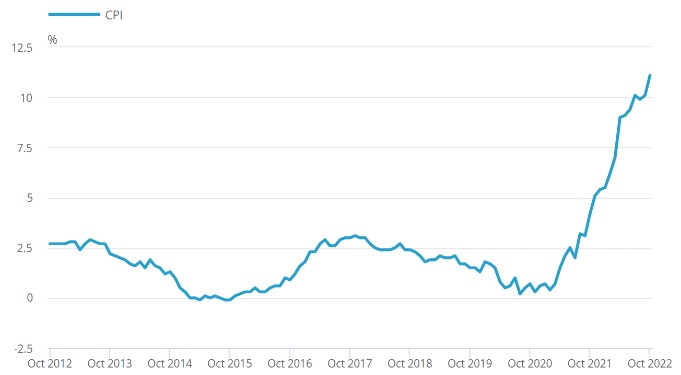With inflation at a 41-year high of 11.1%, UK households have seen food and fuel bills soaring during 2022.
The Consumer Price Index (CPI), though, is just one measure of inflation, based on the average cost of a basket of goods and services.
Not only does the Office of National Statistics (ONS) track different types of inflation, but even the inflation figure for your individual household could be different, based on the type of goods you typically buy, and the services you use.
With this in mind, the ONS has a useful online calculator that you can use to work out your personal inflation figure.
Keep reading to find out why you should use it, what it might tell you, and what you can do about it.
Inflation has been soaring since the UK emerged from coronavirus lockdown
In the summer of 2021, Brits emerged from lockdown with “accidental” savings and a willingness to spend. Consumers, though, were hit by labour shortages, supply chain issues, and a fuel crisis exacerbated by Russia’s February 2022 invasion of Ukraine.
The cost of living crisis has since seen UK inflation reach a 41-year high.

Source: ONS
Alongside rising inflation, fuel prices have rocketed – forcing the government to step in to offer help – and interest rates are also on the rise.
While high inflation tends to disproportionately affect the most vulnerable in society, the scale of the crisis has meant that millions of UK households have suffered.
There are some simple ways to cut energy usage in your home and to budget effectively when times are tough. First, though, you’ll need to understand not only the headline inflation figure, but your personal inflation figure too.
Your personal inflation figure will depend on how you tend to spend your money
CPI is based on a basket of goods and services that mirrors typical household expenditure. This includes food and drink, travel costs, health, communication, and recreation.
While the headline CPI figure for the 12 months to October 2022 was 11.1%, this rise won’t match exactly the rise in each of the above categories.
For example, compared to the 12 months to September, food, drink, and tobacco prices rose significantly more than the cost of clothing and footwear. Transport costs, meanwhile, fell.
The ONS personal inflation calculator uses the CPIH. This measure of inflation is effectively the same basket of goods used to calculate CPI but also includes the costs associated with owning your own home, such as maintenance, repair, and home improvements.
You will be asked to provide rough figures for your household spending in categories including:
- Groceries
- Housing
- Transport
- Leisure
If your household spend each month includes above-average expenditure on travel and clothing, for example, you might find that your personal inflation figure is below the headline rate of 11.1%.
Likewise, if you spend an above-average amount on food and alcohol, your inflation figure could be higher.
Simple budgeting and a focus on long-term goals is key regardless of your personal inflation figure
Whatever the state of your finances, or your personal inflation figure, there are simple steps you can take to stay ahead of the crisis and keep your plans on track.
Begin by reviewing your essential expenditure on things like:
- Mortgage repayments or rent
- Childcare costs
- Credit card payments.
You might find you can start looking for new deals on a mortgage that is soon to reach the end of its current deal. Equally, paying off high-interest debt now could save you over the medium or long term.
Non-essential spending might be easier to cut back on so check whether you can save money by:
- Eating out at restaurants less
- Cancelling subscriptions you don’t use
- Cutting back on car travel.
While you might find you don’t need to cut back, finding areas where you can budget more effectively could allow you to increase pension contributions or add to your investment portfolio. Focusing on your long-term goals – and continuing to pay your future self first – during difficult times, will likely reap huge rewards later on.
Get in touch
While you might be financially secure and stable now, understanding your personal inflation figure can be a huge help when budgeting.
With the cost of borrowing on the rise, and inflation not expected to return to the Bank of England’s 2% target until sometime in 2024, small changes now could make a huge difference.
If you’d like to revisit your long-term plans or want to make small changes to ensure you remain on track to meet your goals, get in touch. Email info@thepensionplanner.co.uk or call 0800 0787 182.
Please note
This blog is for general information only and does not constitute advice. To determine the best course of action for your individual circumstances, please contact us.








 Production
Production